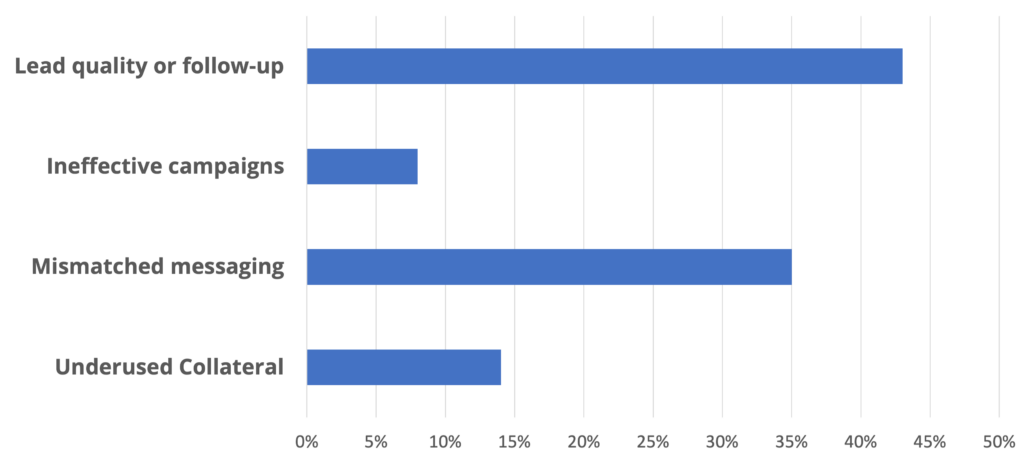Over the past few weeks, I’ve been discussing how to solve the divide between sales and marketing with Peter Meyers of Portage Sales. It’s a common problem for many organizations, leading to a lot of inefficiencies that ultimately result in extra costs or lost revenues.
We had a sense of the challenges based on our experiences working at multiple companies and with the clients we help today. To test our assumptions, we ran a LinkedIn poll and collected a broader set of insights. Surprisingly — or maybe not to some of you — two particular challenges received almost 80% of the votes across our combined polls. A third was mentioned multiple times in comments.
This blog shares the results of that poll and offers some quick thoughts on each. Peter and I are also working on a series of videos that will look deeper and explore some solutions to help your company bridge the sales and marketing divide.

Lead quality or follow-up
Lost sales opportunities due to poor lead quality or follow-up was the biggest source of friction between sales and marketing in our poll, coming in at over 40%. This is not surprising as you hear this back-and-forth often in many organizations:
- Marketing: “Sales never follows up on the leads we send them.”
- Sales: “All the leads from marketing are junk.”
In my opinion, this gap is the most urgent to close — and also the most difficult. Once the fingerpointing starts, it’s hard to overcome and change the behaviours that led to it.
What’s required is a shift in perception and an understanding of what it’s like for the folks on the other side of the imaginary marketing/sales dividing line. The truth is, if leads are passed to sales too early and don’t result in opportunities, then marketing loses credibility that is hard to win back. At the same time, some of these leads likely do have potential — but they need to be followed up on quickly and frequently.
What’s required is a shift in perception and an understanding of what it’s like for the folks on the other side of the imaginary marketing/sales dividing line.
Mismatched messaging
Mismatched sales and marketing messages to customers was the next most common point of contention at 35%. Again, this isn’t surprising. How often have you heard sales and marketing teams separately explain what their business does, how it helps and why it is unique and wondered if they were even talking about the same company?
I’ve written extensively about the need for simple, differentiated and CONSISTENT messaging. Issues with consistency come either from changing messaging too frequently or because different parties don’t buy into it and use their own messages instead. This is definitely a top-ranked issue for good reasons. Aligned marketing and sales messaging is what moves buyers along their journey.
Aligned marketing and sales messaging is what moves buyers along their journey.
Underused collateral
At just under 15%, inadequate or underused sales collateral was the next gap on the list. I’ll admit I am a bit surprised at this result. Not so much that it ranked third, but that it was so far behind the top two. In my experience, the debate around the format and quality of sales collateral is lively in many organizations. Sales tends to view the collateral created by marketing as too fluffy while marketing is sometimes worried that what sales creates doesn’t represent the brand.
There is also the issue that a lot of time and money goes into creating collateral. If it’s not being used, you need to wonder if the investment was worthwhile. Some of the issue starts with the type of content being created and the fact that often one piece tries to address too many audiences or scenarios — making it ineffective at reaching any. It’s important to clearly identify the goal of each piece and then make sure it delivers.
Ineffective campaigns
In retrospect, this challenge may have not been articulated clearly due to LinkedIn’s character limits but marketing budget wasted on ineffective campaigns came in as the fourth biggest challenge with just under 10% of the votes. Marketing and sales campaigns may not work for many reasons, but the fact they are built separately in many companies is definitely one of them.
This ranking may also reflect the fact that ineffective campaigns are largely caused by the other challenges: they’re symptoms of poor lead quality or follow-up, inconsistent messaging and subpar content. Perhaps solving for each of the above will help fix this one, too.
Mismatched goals
We came across this one in the comments related to our poll. A few participants mentioned mismatched goals and out-of-sync performance metrics across departments as important gaps or problems to solve. When I first announced the series, I actually anticipated this, asserting that revenue should be a marketing goal — to better align with sales.
A few participants mentioned mismatched goals and out-of-sync performance metrics across departments as important gaps or problems to solve.
Unfortunately, our LinkedIn poll only allowed four selections, so this one didn’t make the tally, but it appears to rank even above some of the others discussed here. It’s definitely worth exploring further to see if there are solutions beyond making revenue a shared marketing/sales goal.
Bringing sales and marketing together
While the results of this poll are interesting, it’s only the starting point for our upcoming series on Bridging the Sales and Marketing Divide. Over the coming weeks, Peter and I will be releasing a series of videos where we explore these top challenges. He’ll offer the sales perspective and I’ll give the view from the marketing side. We’ll then see if we can come up with some new ideas for how to solve the divide and summarize the key takeaways that you can try in your organization. Stay tuned…


Leave a Reply